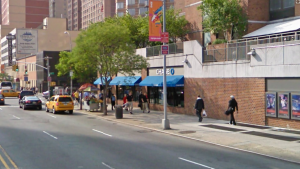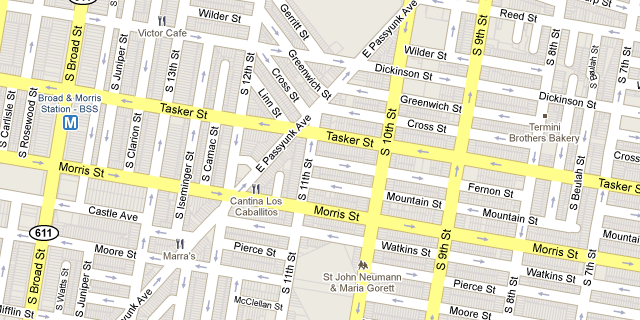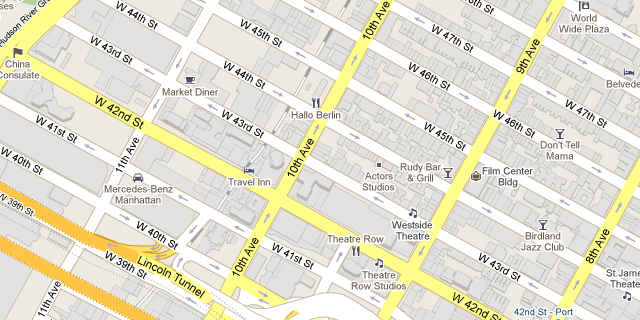As I’ve re-read Great American Cities this summer, I’ve found that the examples in the book are clearer now that I’ve spent a few months each in Philadelphia and New York, two of the cities Jacobs uses for many of her examples.
My wife and I have an apartment in the Passyunk Square neighborhood of South Philadelphia. One of the most striking features of my neighborhood is the high concentration of city streets. The major streets are spaced about 450 feet apart in both the North-South and East-West direction. This would make for relatively short blocks all by itself, but most blocks are further subdivided by one or two side streets, meaning that most city blocks are actually rectangles 450 feet long and 150 to 200 feet wide, like so:
Compare that to Hell’s Kitchen, the neighborhood I’m staying in in New York this summer, shown here on the same scale as the map above:
The contrast is dramatic. Blocks in Hell’s Kitchen are roughly 900 by 300 feet. This seemingly minor difference of geography has a huge effect on the neighborhood’s character. I live in a high-rise apartment building, and my block has only slightly more personality than a cluster of airport hotels. At the base of my building is a bowling alley, a generic restaurant, and small convenience store, but the rest of the block consists mostly of the facades of other large apartment buildings. On the route from my apartment to my subway stop on 8th Ave, I pass a lot of parking garages, chain stores, banks, and the bare facades of large buildings.
 If you turn and walk up a North-South street, you experience the opposite problem. These streets get a lot more foot traffic, and as a consequence they have a lot of shops and restaurants. So many, in fact, that there’s not much space for anything else. Indeed, as you get closer to the middle of the city, the North-South streets can become completely clogged with pedestrians (even before you hit the tourists in Times Square) even as the East-West streets continue to be relatively deserted. In a sense, long blocks tend to segregate residential and commercial uses, with the former in the middles of blocks and the latter at the ends.
If you turn and walk up a North-South street, you experience the opposite problem. These streets get a lot more foot traffic, and as a consequence they have a lot of shops and restaurants. So many, in fact, that there’s not much space for anything else. Indeed, as you get closer to the middle of the city, the North-South streets can become completely clogged with pedestrians (even before you hit the tourists in Times Square) even as the East-West streets continue to be relatively deserted. In a sense, long blocks tend to segregate residential and commercial uses, with the former in the middles of blocks and the latter at the ends.
Our Philadelphia neighborhood is very different. Because blocks are so short, businesses are pretty uniformly distributed throughout our neighborhood. There’s a bodega about 150 feet from our apartment, and half a dozen other convenience stores within 5 minute’s walking distance. There are several bars and restaurants within a block of us, as well as a sizeable fish market and small cobbler.
Even though the neighborhood has a high density of businesses, it doesn’t feel like a particularly commercial neighborhood. The average business is relatively small and surrounded by residential properties. Because they don’t have to jostle for precious space along the few high-traffic corridors, they seem to do a better job of blending in with the surrounding residences.
Short blocks provide pedestrians with many possible routes to get between any two points. And this fact helps to explain the uniform distribution of businesses. First, there aren’t really specific “high traffic” streets. Because the streets are closely spaced in both directions, a business can locate at any one of the neighborhood’s many corners and expect to see a modest but steady flow of foot traffic.
More importantly, short streets generate greater diversity of traffic. A business on 42nd St between 9th and 10th Ave in Manhattan will basically only get traffic from people who work or live on 42nd St. People on 41st or 43rd St. don’t have much reason to go there, and it’s inconvenient to do so. This means that the set of people who might discover that business is sharply limited. In contrast, a business at the corner of 12th St. and Tasker St. in Philadelphia will draw foot traffic from a much wider area. Because people can take varied routes, there will be a much higher proportion of first-time passers-by (a.k.a. potential new customers) for a given volume of foot traffic.
In other words, short blocks enhance the bottom-up discovery process that is the foundation of urban wealth creation. They create more good business locations per square mile and cause more potential new customers to walk past them.





I recently visited your neighborhood in Philadelphia and was so impressed. While I was in town I was also reading The Life and Death of Great American Cities. This post highlights her point very well!
Hi Tim,
Do you see any evidence in Shaw or elsewhere that the movement among city planners away from urban density and toward more suburban, vehicle-dependent designs was partly a reaction to crime, street drug use, homelessness and other “urban blights” that became more pronounced in the early 1960s?
It seems to me that at least in southern California, the municipal planning that took place between the late 1950s and the 1980s was a reaction to the popular view that traditional urban centers were headed for the dustbin of history — crime-ridden, dangerous, overrun by gangs and drugs, and unsafe places for families. As a result, mayors and city councils seem to have pushed for a more decentralized suburban development model, under the logic that less dense areas would suffer fewer of these “externality” problems that plagued cities at the time. In retrospect, as you note, this turns out to have been a huge mistake, as the crime and drug waves were largely due a temporary spike in the number of young men between 15 and 30 post-Baby-Boom, which has now disappeared.
Just wondering if you’ve seen anything exploring this idea that the perceived decline in dense urban areas in the 1960s and 1970s may have pushed city planning toward the more suburban model we see today.
Andrew: yes, I think those ideas were definitely part of the motivation. It’s difficult to separate cause from effect because I think some of the crime was a result of the dislocations created by the freeway projects themselves. But the people making the decisions wouldn’t have noticed that connection, so as the decline of urban cores accelerated, that would have reinforced their view that they needed to give people easier ways to escape to the suburbs.
Oh, God. I don’t think it’s about not having any rgeard for you. He is acting out some kind of weird adolescent head trip and doesn’t see anyone else because his eyes turn inward. I know that at some point, you will be unbelievably relieved not to be with him any longer, but inertia is very hard to overcome. His behavior should help greatly with that, though. And for the record, I don’t feel sorry for his girlfriend – she knowingly got involved with a married man with a family. She deserves the misery she, too, will experience in the future.